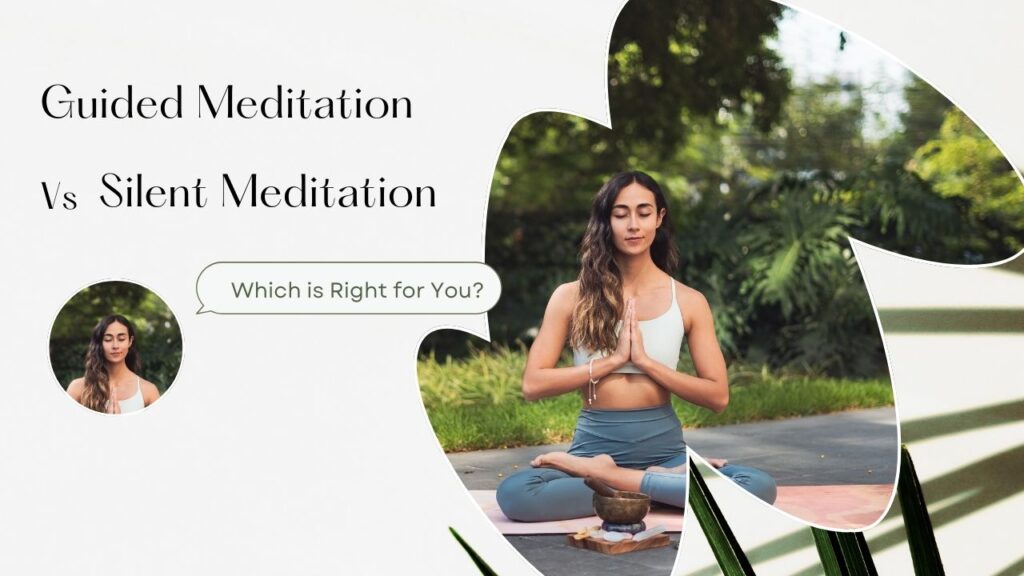Introduction
Meditation has become a go-to practice for those seeking peace, clarity, and a sense of balance in their lives. But with so many styles to choose from, it can be challenging to decide which type of meditation is best for you. Two popular methods are guided meditation and silent meditation. In this article, we’ll explore the differences between these practices, their benefits, and how to determine which one suits your needs best.
Table of Contents
What is Guided Meditation?
Guided meditation involves a narrator or guide who leads you through the meditation process. This could be in person, via a recording, or through an app. The guide’s voice provides instructions on how to focus your mind, breathe, and visualize, often using calming imagery or affirmations.
What is Silent Meditation?
Silent meditation, as the name suggests, involves meditating in complete silence. It requires you to focus inward without any external guidance. Techniques can vary, but common practices include mindfulness meditation, focusing on the breath, or using a silent mantra.
Benefits of Guided Meditation
Provides Structure and Support
Guided meditation offers a structured approach, making it easier to follow, especially for beginners. The guidance helps you stay on track and maintain focus throughout the session.
Ideal for Beginners
If you’re new to meditation, guided sessions can be incredibly beneficial. They provide step-by-step instructions, which can make the practice less intimidating and more accessible.
Helps Maintain Focus
With a guide leading the way, it’s easier to keep your mind from wandering. The ongoing instructions and prompts help bring your attention back whenever it drifts.
Benefits of Silent Meditation
Encourages Deep Introspection
Silent meditation allows for profound self-exploration. Without external guidance, you’re free to delve deeply into your thoughts and emotions.
Enhances Self-Discipline
Practising in silence requires a high level of self-discipline. This discipline can translate into other areas of your life, fostering greater overall resilience and focus.
Fosters a Sense of Inner Peace
Silence can be incredibly calming. Silent meditation helps you develop a profound sense of inner peace and tranquility, as you learn to sit with your thoughts and emotions without distraction.
Comparing Guided and Silent Meditation
Level of Guidance and Support
Guided meditation provides continuous support, which can be helpful if you struggle with maintaining focus or need direction. Silent meditation, on the other hand, requires self-guidance and personal discipline.
Suitability for Different Experience Levels
Guided meditation is generally more suitable for beginners due to its structured nature. Silent meditation may be better for those with some meditation experience who are comfortable with introspection and self-guidance.
Personal Preferences and Goals
Your choice may ultimately come down to personal preference and your specific goals. Do you seek external guidance, or do you prefer introspection? Are you looking to start simply, or are you ready to challenge yourself with silence?
Choosing the Right Meditation for You
Assessing Your Needs and Goals
Consider what you hope to achieve with meditation. If you’re looking for relaxation and stress relief, guided meditation might be a good start. If you’re seeking deeper self-awareness, silent meditation could be more suitable.
Trying Both Types
Experiment with both guided and silent meditation to see which resonates with you. Many people find that their preferences evolve over time, and what works best may change with experience and changing needs.
Mixing and Matching Techniques
You don’t need to pick one over the other. Mixing guided and silent meditation can provide a balanced approach, combining the benefits of both methods.
Common Misconceptions
Guided Meditation is Only for Beginners
While guided meditation is excellent for beginners, it’s also beneficial for experienced practitioners who enjoy the structure and variety it offers.
Silent Meditation is More Advanced
Silent meditation can be challenging, but it’s not exclusively for advanced meditators. Beginners can also benefit from starting with shorter silent sessions and gradually increasing their duration.
Scientific Evidence and Studies
Research on Guided Meditation
Studies have shown that guided meditation can reduce stress, improve focus, and enhance emotional well-being. It’s an effective tool for beginners and experienced meditators alike.
Research on Silent Meditation
Silent meditation has been linked to increased mindfulness, better emotional regulation, and improved cognitive function. It’s praised for its ability to deepen self-awareness and promote mental clarity.
Popular Guided Meditation Resources
Apps and Online Platforms
Popular apps like Headspace, Calm, and Insight Timer offer a wide range of guided meditations for all levels. Online platforms provide access to various guided sessions, often tailored to specific needs.
Books and Audio Guides
Books like “The Miracle of Mindfulness” by Thich Nhat Hanh and audio guides by renowned meditation teachers can offer valuable guidance and insights.
Creating Your Own Silent Meditation Practice
Tips for Getting Started
Start with short sessions, focusing on your breath or a simple mantra. Gradually increase the length of your sessions as you become more comfortable with silence.
Setting Up a Meditation Space
Create a quiet, comfortable space for your practice. This can help minimize distractions and make it easier to focus inward.
Combining Guided and Silent Meditation
Benefits of a Hybrid Approach
Combining guided and silent meditation can provide the best of both worlds. Guided sessions can help you build a foundation, while silent sessions can deepen your practice.
Examples of Combined Practices
Start with a guided meditation to relax and focus, then transition into silent meditation to explore your inner thoughts and emotions.
Real-Life Stories and Testimonials
Experiences from Guided Meditation Practitioners
Many people find that guided meditation helps them stay committed to their practice and provides the support they need to navigate life’s challenges.
Experiences from Silent Meditation Practitioners
Silent meditation practitioners often report profound personal insights and a deep sense of peace that comes from sitting with their thoughts without distraction.
Overcoming Challenges in Meditation
Common Obstacles in Guided Meditation
Distractions from the guide’s voice or background noises can be a challenge. Choose a guide whose voice and style resonate with you to minimize these distractions.
Common Obstacles in Silent Meditation
Staying focused without guidance can be difficult. Begin with more limited meetings and continuously increment the span as your centre moves along.
Conclusion
Both guided and silent meditation offer unique benefits and can play an important role in your meditation practice. Whether you prefer the structured support of guided sessions or the deep introspection of silent meditation, the key is to find what works best for you. Explore both methods, mix and match as needed, and enjoy the journey towards greater peace and self-awareness.
FAQS On Guided Meditation vs. Silent Meditation
Q1: Can I switch between guided and silent meditation?
Ans: Yes, you can switch between the two based on your needs and preferences.
Q2: How long should a beginner meditate?
Ans: Begin with 5-10 minutes and continuously increment the length as you become more agreeable.
Q3: Do I really want any unique hardware for reflection?
Ans: No special equipment is needed. A quiet space and comfortable seating are sufficient.
Q4: Which type of meditation is better for stress relief?
Ans: Both guided and silent meditation can be effective for stress relief. It depends on your personal preference.
Q5: Can I combine guided and silent meditation in one session?
Ans: Absolutely. Starting with guided meditation and transitioning to silent meditation can be a great way to deepen your practice.



